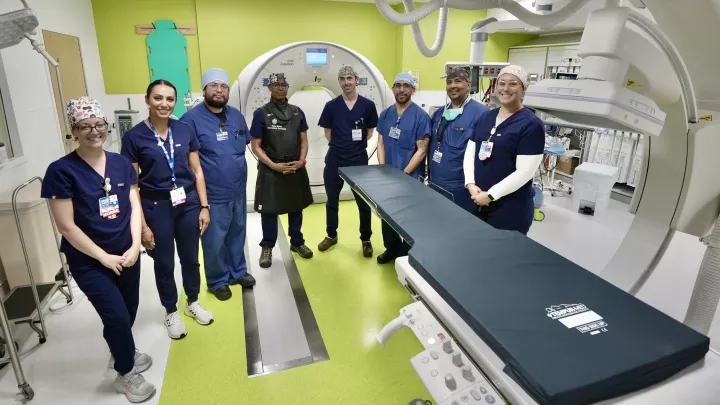Imaging and Interventional Radiology for Vascular Anomalies
Children’s Hospital Los Angeles has an interventional radiologist specializing in vascular anomalies. This expert delivers precise tests and treatments that are gentler on growing bodies. We can diagnose the most complicated cases with a high degree of accuracy. We also offer advanced therapies that help many children avoid surgery.
The vascular system moves blood and lymph (a clear fluid that’s part of the immune system) throughout the body. Vascular anomalies can block the flow of blood and lymph, affecting appearance and function. Interventional radiology uses real-time imaging and minimally invasive techniques to assess and treat blood and lymphatic vessels deep inside the body. These techniques, which include embolization, enable us to safely treat some of the most complicated anomalies.
Vascular Anomalies Imaging and Interventional Radiology: Why Choose Us
At Children’s Hospital, your child is in caring and capable hands. The same specialist provides diagnostic imaging and interventional radiology services. This leads to efficient, more precise treatment. It also helps your child avoid unnecessary radiation exposure while receiving the best possible care.
Highlights of our program include:
- Embolization instead of surgery: Vascular anomalies that are large or located in sensitive areas like the neck are difficult to remove surgically. They also sometimes come back. We often use embolization, also known as sclerotherapy. The procedure works by injecting a substance into abnormal vessels to close them off. We maintain high success rates with these procedures.
- Medical appropriateness: Our team approach ensures we only offer procedures when they will result in significant benefits with the lowest possible risks to your child. Our interventional radiologist works with other specialists, including dermatologists, surgeons and hematologist-oncologists, to plan treatments. We consider every possible option, including medical treatments.
- Focus on safety: Specialized technologies help us get images using the lowest possible radiation dose. Radiology tests and procedures typically require putting your child to sleep. But Children’s Hospital is among the safest places your child can be. Our renowned pediatric anesthesiologists tailor sedation medications to your child’s needs.
- Timely treatments with minimal side-effects: Preserving your child’s positive self-image is an essential part of our care. We often treat large malformations in visible areas before they become a cosmetic concern to your child. And interventional radiology procedures typically use tiny needles that leave no scars.
Embolization for Vascular Anomalies
Embolization involves angiography, which uses long tubes (catheters) to assess blood and lymphatic vessel anomalies from inside the body. We are among the few pediatric hospitals in the country with integrated angiography and computed tomographic (CT) scanning capabilities.
This technology provides sophisticated, real-time blood flow analysis and mapping. It enables us to deliver embolization with a high degree of precision and the lowest necessary radiation dose. We can also deliver treatments quickly, which means less time under anesthesia and a faster recovery.
What to expect during embolization
Here’s what happens during embolization:
- Our pediatric anesthesiologist uses medications to help your child go to sleep. These drugs also temporarily block sensation.
- The interventional radiologist uses real-time imaging to insert a small needle into the abnormality or a blood vessel that leads to it.
- We use imaging to study the anomaly from the inside, assess blood flow and plan therapy.
- We then usually inject an embolic agent. This substance blocks the flow of blood or lymph to the anomaly. Or it may replace the anomaly with scar tissue.
- The procedure is complete. We remove the needle and cover the incision with a bandage. Your child goes home the same day.
- For large malformations, it’s sometimes necessary to perform embolization more than once.
Vascular Anomalies Diagnostic Imaging
For some vascular anomalies, imaging is essential for diagnosis and treatment planning. Our interventional radiologist reviews all imaging scans, even if they are not from Children’s Hospital.
If your child needs an imaging study, we offer every available option. Vascular malformation diagnostic imaging may include:
- Angiography, which enables detailed blood and lymph flow analysis. It also aids surgical planning when more minimally invasive procedures are not an option.
- Computed tomography (CT) scan, which captures X-ray images from multiple angles. Special technology puts them together for detailed, 3D views.
- Magnetic resonance imaging (MRI), which may be necessary for complex malformations. This test uses a powerful magnet and radio waves to assess vessels, organs and nearby tissue.
- Ultrasound, which uses sound waves to examine malformations beneath the skin’s surface.
Second Opinions and Adult Consultations for Interventional Radiology
If your child is not a Children’s Hospital patient, we welcome the opportunity to review the case. Hearing from multiple specialists, including our interventional radiologist, is especially helpful for malformations that do not respond to standard therapies. Get more information about online second opinions.
Adult consultations are for patients 21 and older who have signs or symptoms of vascular anomalies. This includes those whose symptoms do not appear until later in life or who have ongoing care needs. We provide personalized care recommendations and may coordinate a referral to an adult interventional radiologist.
Comprehensive Vascular Anomalies Care for Children
We offer access to multiple pediatric subspecialists in one convenient location in Los Angeles. Find out more about our Vascular Anomalies Center.


